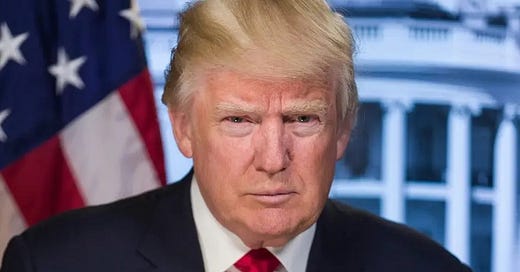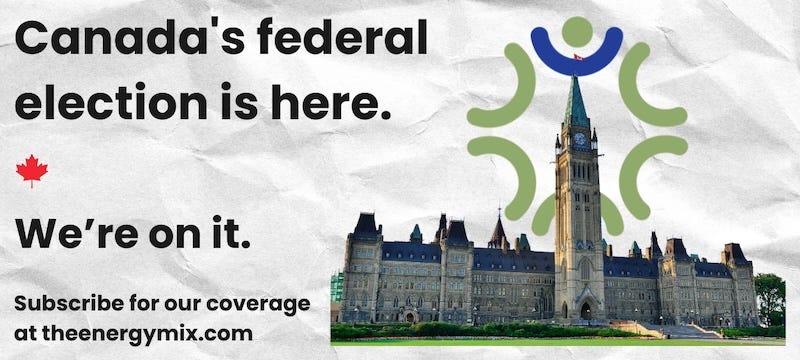Trump is Serious About Annexing Canada. How Will Climate and Energy Policy Bring Us the Allies We Need?
Canada might yet place itself at the centre of the world's next great, low-carbon trading bloc, as long as our incoming federal government has the insight and inclination to make it happen.

Today’s Weekender mostly combines material we published in late February and early April, but the context is a bit more urgent…again.
Monday is Election Day in Canada, and with less than 100 hours to go before polls open, Donald Trump reinserted himself into the campaign, telling TIME Magazine he’s “really not trolling” with his mutterings about turning us into a 51st state.
In an interview published Friday, Trump brought the focus back to the annexation threat that The Weekender and many others have been warning about for months. He repeated his false claims that the U.S. is subsidizing Canada, declaring that “the only way this thing really works is for Canada to become a state."
“It now seems increasingly obvious that Trump's expansionist aspirations are no fleeting fancy,” CBC writes. “He kept quiet for a while, leading some to wonder whether he'd gotten it out of his system.” But “in recent days, the president has been blunt in different encounters with media that he seriously would love to see Canada become a state.”
Trump’s apparent seriousness about annexation leads to two questions, the answers to which may well be shaped by the election results Monday night:
• What are the prospects for Canada to form new trading relationships with other regions and countries that are facing Trump’s malignant wrath, to diversify our economies and stand together against a common threat?
• How can climate and energy strategy become part of the glue that holds this new alliance together, and what policies and real-world actions will Canada need to join in?
The World Pushes Back
The astonishing thing over the last few weeks was not that Donald Trump went ahead with his threat to blow up the global trading system by imposing tariffs on about 60 countries, including two economically mischievous islands populated only by penguins.
It was that the rest of the world was so fast to push back, ready and determined to move on from an era of U.S. economic dominance. That a promising approach to building a new trading bloc that bypasses the rogue regime in the White House went from online conversation to serious proposition in scarcely a week.
That if you surveyed the scene from just the right angle, a new, emerging bloc might be able to cover more ground and tackle multiple problems at once by pivoting to low-carbon goods and real decarbonization technologies.
And that Canada might yet place itself at the centre of the world’s next great, low-carbon trading alliance, as long as our incoming federal government has the insight and inclination to play along. (Which is a longabouts way of saying…your vote matters.)
In the 100 or so hours after Trump’s self-styled “Liberation Day” announcement earlier this month, we saw a fast flurry of analyses on the slapdash, amateur-hour process behind the decision, the immediate impact on jobs, a shock reaction from global stock markets that has continued through the month, and the apparent certainty that this spells the end of global trade as we’ve known it.
But there are more interesting, even hopeful and positive questions to ask, beginning with:
If every end is also a beginning, what’s next?
If the tariffs are really dealing a death blow to the established international trading system, what if this undercuts the fossil fuel industry as badly as Trump’s direct hostility and interference have devastated the U.S. renewable energy sector and climate justice community?
For Canada, now that we’ve declared that there’s no way back to an era when our economy was over-dependent on our neighbour to the south, what else do we gain by getting closer to countries that are farther along on their climate and decarbonization journey?
And how can we work with our future trading partners to accelerate the shift?
Sleeping Beside an Elephant
The roiling, ranting, manufactured crisis that Donald Trump has brought to our doorstep has communities, countries, and whole continents scrambling for solutions. So we might as well admit and embrace the reality staring right at us—Trump has created a moment when the sense of what’s “realistic” gets tossed in the air, when unexpected lines of thought suddenly make a whole lot more sense.
For Canada, that response begins with a level of unity and shared purpose that we haven’t seen in many decades—prompting former prime minister Jean Chrétien to slyly declare that he would have nominated Trump for an Order of Canada if only the honour were available to convicted criminals.
It extends into some serious, long-overdue conversations about how to make our economy truly independent. We’ve always known we were sleeping beside an elephant, as Prime Minister Pierre Trudeau told the Washington Press Club in 1969.
But there’s been little serious talk about dialling up our economic relationships in other parts of the world sufficiently to dial back our dependence on the U.S. Until now.
It began with a post by Social Capital Partners Chair Jon Shell, suggesting a new trading bloc with the economic clout to survive, thrive, and leave the United States behind.
“We know what Donald Trump is afraid of,” he wrote on LinkedIn. “Now let's organize around it.”
The EU, UK, Canada, Japan, South Korea, and Australia (I'm now calling them "EU + 5") collectively have 760 million people and control 34% of the global economy and vast quantities of natural resources. We are an obvious threat to the U.S. and to China if we were to organize.
The best way to beat a bully is for the rest of the group to rise up against him.
The rest of Shell’s scenario is that much more plausible in the year when Canada holds the rotating chair of the Group of 7 forum of industrialized nations, and will be hosting the G7 leaders’ summit in June.
The most powerful signal to give Trump would be for this group to meet in a very public way, ideally in Canada, so the meeting would play out on American TV in the right time zones. The stats on the economic and resource might of this new group would scroll across the bottom of Fox News. [If we can assume that Fox would even carry the story—Ed.]
A joint statement at the end pledging to work together as friends and allies to ensure a resilient and prosperous future for our populations would be a powerful message. Quick wins could be action on Ukraine and munitions manufacturing.
First and last, it needs to be 100% clear—and for Trump, spelled out with a Sharpie in simple, single-syllable words with lots of golf analogies—that no one is taking this lying down.
“My strong recommendation to Canada, Mexico, Japan, the United Kingdom, and the European Union is to join together to create a free trade zone that excludes the United States, imposing at least a 10% tariff on all imports from America,” writes Bill Clinton-era U.S. labour secretary Robert Reich. “Don’t negotiate. Do this now so you’ll be negotiating from a position of power.”
G7? Meet the ‘Free 7’ (By Comparison)
As Reich’s formula suggests, a useful add-on to Shell’s thinking would be to build on Canada’s relationship with its more reliable trading partner in North America by including Mexico in an EU + 6.
And by declaring an emphasis on clean energy and decarbonization trade, the countries could jump-start their economies after Trump’s tariff attack, boost affordability and local self-reliance across the entire bloc, support Ukraine’s reconstruction, and prevent military conflict in the first place—and oh, by the way, move closer to meeting their climate targets.
The focus on climate and carbon would be consistent with the accelerated priorities the European Union has been setting since 2022, when Vladimir Putin’s invasion of Ukraine turned energy efficiency and renewables into a geopolitical security strategy for countries that were too dependent on Russian gas.
And this general line of thought has been gaining traction. Within a week, the idea of a wider trading bloc had broken out from social media and Substack newsletters to general media in a Toronto Star post by John Austin, a nonresident senior fellow at the Washington, DC-based Brookings Institution. His formulation brought together the EU, Japan, the UK, Canada, Mexico, South Korea, and Thailand in a group of nations that “would dwarf the U.S., as well as the economies of China combined with its ally Russia.”
Given America’s new stance, now is the time for the G7 member nations to disinvite the U.S. from the group, and morph to a new organization: a “Free 7.” It would be a new forum in which the nations that still believe in democracy, free markets, freedom of expression, and free trade would collaborate to strengthen their collective hand and push back against authoritarians—which now includes the U.S.
The work of the new Free 7 would be the urgent task of building an international coalition that stands up to the authoritarian axis—and successfully contains it. This means standing up to pressure from the U.S.
Take this as a thumbs-up for the basic idea, not necessarily the branding Austin attaches to it. It would take a whole other edition of The Weekender (or more) to unpack what we mean by “Free” and how well or widely it applies to the countries in the group, certainly including Canada.
But the point of contrast with full-on authoritarians like Trump still makes a lot of sense—to counter the rush to fascism that we’re seeing in the U.S. and, if it goes this way, to reignite the response to climate change and the energy transition. That general line of thought makes South Korea an interesting addition to the group after an unequivocal population pushed back against an egregious assault on the country’s democracy—unlike their U.S. counterparts, who splintered in response to Trump’s 2020 election loss and the deadly insurrection attempt that followed.
Carbon is the New Tariff
In February, The Weekender reported that the emerging, global demand for low-emissions trade isn’t just a North American phenomenon—nor even a trend that North America is leading. And that carbon controls could soon become the new tariff.
The European Union adopted the world’s first carbon border adjustment mechanism (CBAM) in 2023, and its implementation is set to begin this year. That bit of progress landed in the middle of the Liberal leadership campaign earlier this year when then-candidate Mark Carney proposed to replace the hated consumer carbon tax by introducing a CBAM regime with other like-minded countries.
That thinking leads toward a plausible and really promising future where climate impact is a key criterion guiding trading relationships, as long as the system is rigorous enough to deliver real-world results. If a country is seriously and measurably reducing emissions, it qualifies. If it isn’t, it gets politely but firmly left behind.
As far back as January, Canada’s future trading partners were already making moves in the right direction. In the first week after Trump’s inauguration, a small flurry of analysis indicated that the rest of the world was moving on—not least because countries have already seen eight years of punitive, provocative U.S. tariffs under the Joe Biden presidency as well as Trump 1.0, and they’re quite rightly fed up.
The trend was most definitely parallelled by an emerging, global shift in energy priorities. “Most major economies are investing in ever-cheaper solar and wind power,” the New York Times wrote. “Even as coal, oil, and gas still power the global economy, and more fossil fuels are burned year after year, the movement globally is toward heavy investment in solar, wind, and batteries, the prices of which have fallen sharply in recent years.”
Time to Stand for What Matters
But in international trade relations, as in the fight against climate change, standing against what we can’t and won’t accept is just half the battle. The next successful trading bloc will only fulfill John Austin’s vision of a “Free 7” if we’re very clear and deliberate about the kind of economic activity we want.
In a Toronto Star op ed, Savanna McGregor, Grand Chief of the Algonquin Anishinabeg Nation Tribal Council, said Conservative Leader Pierre Poilievre’s “Canada First” National Energy Corridor wouldn’t meet that standard.
Reading Mr. Poilievre’s announcement, I am left wondering why it does not mention Indigenous people even passingly, other than to expect fancifully that we give “approval … before any money is spent.” Surely he knows Canada’s constitution requires Indigenous consultation, accommodation, and ultimately consent to build major infrastructure inside his National Energy Corridor? How can there be consultation (to say nothing of accommodation and consent) if the corridor is “pre-approved” before anyone has the blueprints for what infrastructure will be built and where?
McGregor asks how city dwellers would respond to word of a “pre-approved” major development in their own back yard, with no indication of whether it’s a school, a shopping mall, or a radioactive waste dump.
It sounds ridiculous and contemptuous, yet this is exactly how Mr. Poilievre and many others hold Indigenous communities today (there is a radioactive waste dump on Algonquin land right now). Obviously, pushing a development decision without identifying the development would never fly in a city where the residents have no constitutional right to be consulted—so it definitely will not fly for Indigenous people having that right.
“Ironically, the pre-approved corridor Mr. Poilievre wants to speed development up would nearly paralyze it,” McGregor wrote, citing court cases that would slow down a campaign promise that she describes as a “war with Indigenous nations”.
Then there’s the question of who gains if those projects are fast-tracked. In a separate post for the Star, Toronto Metropolitan University associate professor Shari Pasternak and Emily Lowan, fossil fuel supply lead at Climate Action Network Canada (of which Energy Mix Productions is a member), connected dots to some of the main movers and shakers in Trump’s inner circle. Which means that projects like the Prince Rupert Gas Transmission (PRGT) pipeline and the Ksi Lisims LNG export terminal “are now making Canada vulnerable to Trump’s predatory goal of North American energy dominance.”
Pasternak and Lowan wrote:
The solution is not to copy Trump’s “drill, baby, drill” approach with a thin gloss of maple syrup over top; it is respect for Indigenous jurisdiction and a just transition from fossil fuels to clean energy. Canadian pride should come from ethical investment and reconciliation—not backstopping U.S. corporations.
We’ve all heard the too-easy, too-glib line that a crisis is a terrible thing to waste. And once, just once, I wish the pundits and prognosticators who keep talking that way would turn their attention to the climate crisis and the fossil fuel industries that drive it. Or the nature and biodiversity crisis. Or the food security crisis. Or the multiple, wrenching human rights crises going on around the world as we virtually speak. No need to be fussy.
But here’s the thing so many of us have been hoping for—since the U.S. election result in November, and since around 8:10 PM Eastern last June 27, as we watched then-U.S. president Joe Biden implode onstage in his debate against Trump. Faced with the worst we’ve ever seen from Trump, the #ElbowsUp mantra is extending far beyond Canada, into a global coalition so wide that it might be able to withstand this moment, recover, thrive—and thrive green.
There are no guarantees, and it’ll take a while to see how things land. But the first step in building the solution we need is to envision it. And over the last few weeks, that’s been happening.
Mitchell Beer traces his background in renewable energy and energy efficiency back to 1977, in climate change to 1997. Now he and the rest of the Energy Mix team scan 1,200 news headlines a week to pull together The Energy Mix, The Energy Mix Weekender, and our weekly feature digests, Cities & Communities and Heat & Power.
Chart of the Week

‘Kind of Shocking’: Election Result Could Make Canada the Only G7 Country with Rising Emissions
Climate (Still) on the Ballot as Federal Parties Release Costed Platforms
Trump Blinks in Earth Day Assault on U.S. Climate Non-Profits
Trump Administration Policies Spark Buying Spree for Low-Priced Clean Energy Stocks
How Earth Day 1970 Sparked a Lifetime of Environmentalism
Trump Crackdown on U.S. Wind Projects Prompts Call for Equinor to Look North
Nuclear Energy Means Climate Action Delay: O’Donnell and Winfield
Toronto Bike Lane Removal Blocked by Temporary Injunction
Inside Blatchford, Edmonton’s Gas-Free, Carbon-Neutral Community
B.C. loosens net-zero rules for LNG proposals amid hydroelectricity uncertainty (Globe and Mail)
B.C. village struggling to survive following economic impact of Jasper wildfire (Canadian Broadcasting Corporation)
U.S. sets tariffs of up to 3,521% on South East Asia solar panels (British Broadcasting Corporation)
Not Just ‘Rare Earths’: U.S. Gets Many Critical Minerals From China (New York Times)
10 charts prove that clean energy is winning — even in the Trump era (Vox)
Trump’s war on clean energy just killed $6B in red state projects (Electrek)
Global energy supplies still vulnerable to shocks, warns IEA (Financial Times)
Climate Change Is Stressing the World’s Blood Supplies (New York Times)
Europe’s Top Ski Resorts Shut as Record Snow Risks Avalanches (Bloomberg)
The Trump administration is sabotaging your scientific data (The Guardian)
Haven to install free solar, batteries for thousands of California homes (Canary Media)
Utilities are shedding crocodile tears over community solar ‘cost-shift’ (Utility Dive)
Piles of research on why we should promote bike lanes, bikes, e-bikes and e-scooters (Lloyd Alter/Carbon Upfront!)








Brilliant! This post makes my heart sing over the magnificent potential of break ing through entrenched old world views. Thanks for this, Mitchell. I follow Reich almost daily, but hadn’t yet come across the superb concept of a ‘Free 7’.